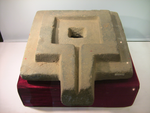Yoni (Sanskrit: योनि, IAST: yoni), sometimes called pindika, is an abstract or aniconic representation of the Hindu goddess Shakti.[3][4] It is usually shown with linga – its masculine counterpart.[3][5] Together, they symbolize the merging of microcosmos and macrocosmos,[5] the divine eternal process of creation and regeneration, and the union of the feminine and the masculine that recreates all of existence.[4][2] The yoni is conceptualized as nature's gateway of all births, particularly in the esoteric Kaula and Tantra practices, as well as the Shaktism and Shaivism traditions of Hinduism.[6]
Yoni is a Sanskrit word that has been interpreted to literally mean the "womb",[2][7] the "source",[8] and the female organs of generation.[9][10] It also connotes the female sexual organs such as "vagina",[4] "vulva",[11][12] and "uterus",[13][14] or alternatively to "origin, abode, or source" of anything in other contexts.[1][4] For example, the Vedanta text Brahma Sutras metaphorically refers to the metaphysical concept Brahman as the "yoni of the universe".[15] The yoni with linga iconography is found in Shiva temples and archaeological sites of the Indian subcontinent and southeast Asia,[16][17][18] as well in sculptures such as the Lajja Gauri.[19]
- ^ a b Monier-Williams, Monier. "Yoni". Harvard University Archives. p. 858. Archived from the original on 3 March 2009.
- ^ a b c Lochtefeld, James G. (2001). The Illustrated Encyclopedia of Hinduism, Volume 2. The Rosen Publishing Group. p. 784. ISBN 978-0-8239-3180-4.
- ^ a b Dasgupta, Rohit (26 September 2014). Kimmel, Michael; Christine Milrod; Amanda Kennedy (eds.). Cultural Encyclopedia of the Penis. Rowman & Littlefield. p. 107. ISBN 978-0-7591-2314-4.
- ^ a b c d Doniger, Wendy; Stefon, Matt (24 December 2014) [20 July 1998]. "Yoni (Hinduism)". Encyclopædia Britannica. Edinburgh: Encyclopædia Britannica, Inc. Retrieved 22 May 2021.
- ^ a b Beltz, Johannes (1 March 2011). "The Dancing Shiva: South Indian Processional Bronze, Museum Artwork, and Universal Icon". Journal of Religion in Europe. 4 (1). Brill Academic Publishers: 204–222. doi:10.1163/187489210x553566. S2CID 143631560.
- ^ Cite error: The named reference
JonesRyan2006p516was invoked but never defined (see the help page). - ^ Indradeva, Shrirama (1966). "Correspondence between Woman and Nature in Indian Thought". Philosophy East and West. 16 (3/4): 161–168. doi:10.2307/1397538. JSTOR 1397538., Quote: "Nature is my yoni (womb), [...]"
- ^ Grimes 1996, p. 361.
- ^ Adams, Douglas Q. (1986). "Studies in Tocharian Vocabulary IV: A Quartet of Words from a Tocharian B Magic Text". Journal of the American Oriental Society. 106 (2). JSTOR: 339–341. doi:10.2307/601599. JSTOR 601599., Quote: "Yoni- 'womb, vulva', Yoni- "way, abode' is from a second PIE root [...]";
Indradeva, Shrirama (1966). "Correspondence between Woman and Nature in Indian Thought". Philosophy East and West. 16 (3/4). JSTOR: 161–168. doi:10.2307/1397538. JSTOR 1397538. - ^ Abhinavagupta (1989). A Trident of Wisdom: Translation of Paratrisika-vivarana. Translated by Jaideva Singh. State University of New York Press. pp. 122, 175. ISBN 978-0-7914-0180-4., Quote: "yoni or womb [...]" p. 122, "[...] in the female aspect, it is known as yoni or female organ of generation [...], p. 175"
- ^ Cheris Kramarae; Dale Spender (2004). Routledge International Encyclopedia of Women: Global Women's Issues and Knowledge. Routledge. p. 1840. ISBN 978-1-135-96315-6., Quote: "The sculpted image of the lingam usually stands erect in a shallow, circular basin that represents the yoni."
- ^ Cite error: The named reference
MeulenbeldLeslie1991p57was invoked but never defined (see the help page). - ^ Cite error: The named reference
renouwas invoked but never defined (see the help page). - ^ Gerd Carling (2003). "New look at the Tocharian B medical manuscript IOL Toch 306 (Stein Ch.00316. a2) of the British Library - Oriental and India Office Collections". Historische Sprachforschung / Historical Linguistics. 116. Bd., 1. H. (1): 75–95. JSTOR 40849180., Quote: "[...] diseases of the yoni (uterus and vagina) [...]";
Shivanandaiah, TM; Indudhar, TM (2010). "Lajjalu treatment of uterine prolapse". Journal of Ayurveda and Integrative Medicine. 1 (2): 125–128. doi:10.4103/0975-9476.65090. PMC 3151380. PMID 21836800., Quote: "[...] vaginal-uterine disorders (Yoni Vyapat) [...]";
Frueh, Joanna (2003). "Vaginal Aesthetics". Hypatia. 18 (4). Wiley: 137–158. doi:10.1111/j.1527-2001.2003.tb01416.x. S2CID 232180657. - ^ Klostermaier, Klaus K. (1998). A Concise Encyclopedia of Hinduism. Oneworld Publications. p. 214. ISBN 978-178074-6-722.
- ^ Cite error: The named reference
Urban2009p2was invoked but never defined (see the help page). - ^ Cite error: The named reference
hardy103was invoked but never defined (see the help page). - ^ Lopez, Donald S. (1995). Religions of India in Practice. Princeton University Press. pp. 304–307. ISBN 978-0-691-04324-1.
- ^ Cite error: The named reference
bolon1997p40was invoked but never defined (see the help page).

